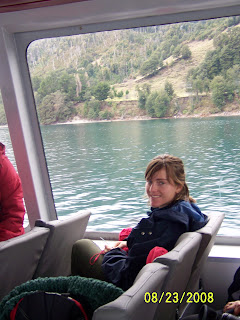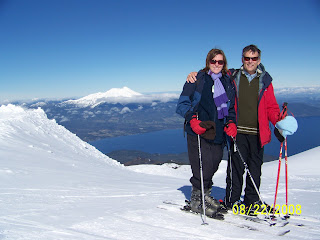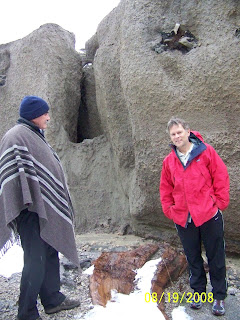
 Amber was in heaven to have Dad finally spring for some real restaurants. There were lots of little artisans shops selling hand knitted items and alerce wood products for 3 or 5 dollars. We bought the local drink, Pisco Sour, which we later tried with mango and coconut flavors.
Amber was in heaven to have Dad finally spring for some real restaurants. There were lots of little artisans shops selling hand knitted items and alerce wood products for 3 or 5 dollars. We bought the local drink, Pisco Sour, which we later tried with mango and coconut flavors.
Colorful houses and shops in Ancud
The next day we checked out the local museum where they had more artisan booths, we particularly enjoyed speaking to the model boat builder, who had no teeth, who was proud to hear we had seen his boat model in the Santiago history museum. On the way to the Spanish fort (their last stronghold in the Americas) it began to rain, and I mean pouring rain, so we never made it.

View from room in Ancud youth hostel
We got on a bus south to Chonchi, a town on the east coast, staying at the dreary but ocean front Esmeralda by the Sea Hostel. This was owned by a Canadian man and his 2 sons, one of whom introduced us to the tiny town. We went straight to the local restaurant and got a seafood brunch, which is always fun, even if it was raining. The hostel was our most expensive, at $40, we were the only guests, the room was dirty as they usually dont have guests in winter. It was also freezing in the flimsily constructed wood building, battered for years by storms.
The 27th we enjoyed pancakes with our ocean front view of the bay. We decided to take the bus to Quellin, at the south of the island, where we hoped to see the erupting Chaiten volcano. That would have been a first. They had to evacuate 2 towns recently because of all the soot, which was blowing east into argentina. However after an hour of waiting in the cold, we took the bus back north to Ancud, where we ate in our favorite restaurant again. We visited the Spanish fort and I bought some salmon leather from a Mapuche artisan (who loved listening to the rock band Police). He made right in front of me a salmon leather and horse hide coin purse, for 3 dollars. We bought our bus ticket to Bariloch, Argentina, an 8 hour trip costing $26 per ticket.
Traveling by bus is inexpensive and easy, and the buses are modern with TV´s, music and great seats. Our trip went north to Osorno, then east over the Andes for a 2nd time into Argentina. It was raining, which turned to snow as we gained altitude. It was easy crossing the border, the Argentine customs are much less stringent, no bag searches for instance. Finally arriving in Bariloche, we found the bus station miles from town, and we had not enough argentine money to take a taxi, but we had just enough to take a very very crowded bus. Our hostel 1040 we chose was on the 10th floor of a building with stupendous views over the lago nahuel huapi, 360 square miles big with 'arms' 60 miles long. We were in a dorm room with 3 bunk beds, with 2 other Americans and a French guy. It was still hard to sleep for me, stuffy and a bit noisy, but not too bad.
We were talking with a girl at breakfast, she was from Santa Ynez, I asked if she knew my runner friend Leah Etling, and she had gone to school with Leah! What a coincidence! I emailed Leah immediately to tell her
I am getting ahead of myself, as I was supposed to blog about Chiloe and Amber is to blog about Bariloche. Suffice to say we really like it here, it is a bit like Chamonix France, kind of upscale, but lots to do in the surrounding region. It has one of the best ski resorts in Argentina, Cerro Catedral, which you can take public buses to. We will probably stay here our last 2 weeks. It is snowing now and the town is covered with abeautiful layer of fresh snow! Very cool! There is an American who has been here for 3 months, writing a book.





 (Another view from boat.)
(Another view from boat.)



 (Picture: Amber and Gonzalo in Elvish forest)
(Picture: Amber and Gonzalo in Elvish forest) STREAM CROSSING ON SLIPPERY LOG
STREAM CROSSING ON SLIPPERY LOG CHECK OUT THE CONDITIONS ON THE TRAIL IN WINTER
CHECK OUT THE CONDITIONS ON THE TRAIL IN WINTER


 GONZALO, OUR HANDSOME MAPUCHE CHILEAN SURVIVORMAN GUIDE
GONZALO, OUR HANDSOME MAPUCHE CHILEAN SURVIVORMAN GUIDE








 WALKING UP TO THE LIFTS FROM THE REFUGE TESKI
WALKING UP TO THE LIFTS FROM THE REFUGE TESKI
 VOLCANO CABULCO IN THE BACKGROUND, A RARE SUNNY WINTER DAY IN CHILE
VOLCANO CABULCO IN THE BACKGROUND, A RARE SUNNY WINTER DAY IN CHILE AMBER SKIING TO THE LEFT OF CHAIR 2 AROUND THE HILL TO ADVENTURE
AMBER SKIING TO THE LEFT OF CHAIR 2 AROUND THE HILL TO ADVENTURE


 WE DROVE AS FAR AS WE COULD BEFORE SNOW STOPPED THE CAR
WE DROVE AS FAR AS WE COULD BEFORE SNOW STOPPED THE CAR
 COW WITH WATERFALL
COW WITH WATERFALL  SWINGING BRIDGE, THE ONLY WAY TO GET TO HOUSES FROM THE ROAD
SWINGING BRIDGE, THE ONLY WAY TO GET TO HOUSES FROM THE ROAD



 GREAT WEATHER AND LOCAL FARMS
GREAT WEATHER AND LOCAL FARMS


